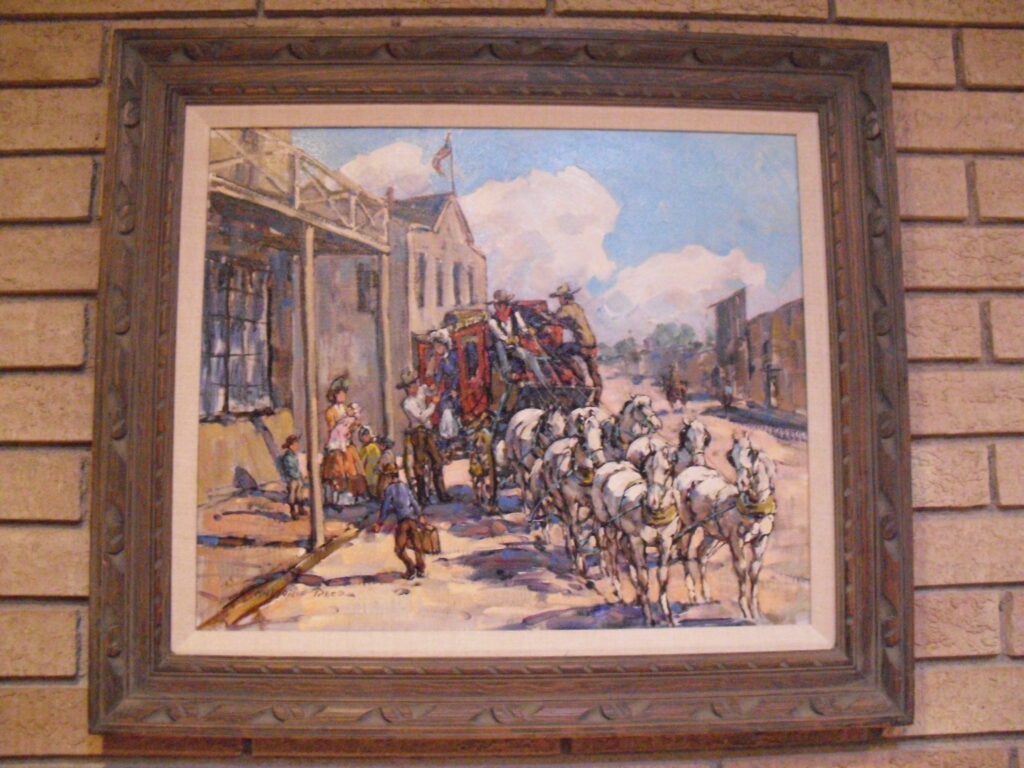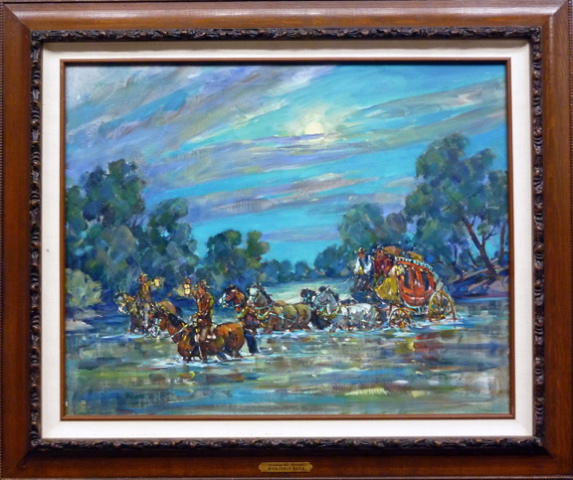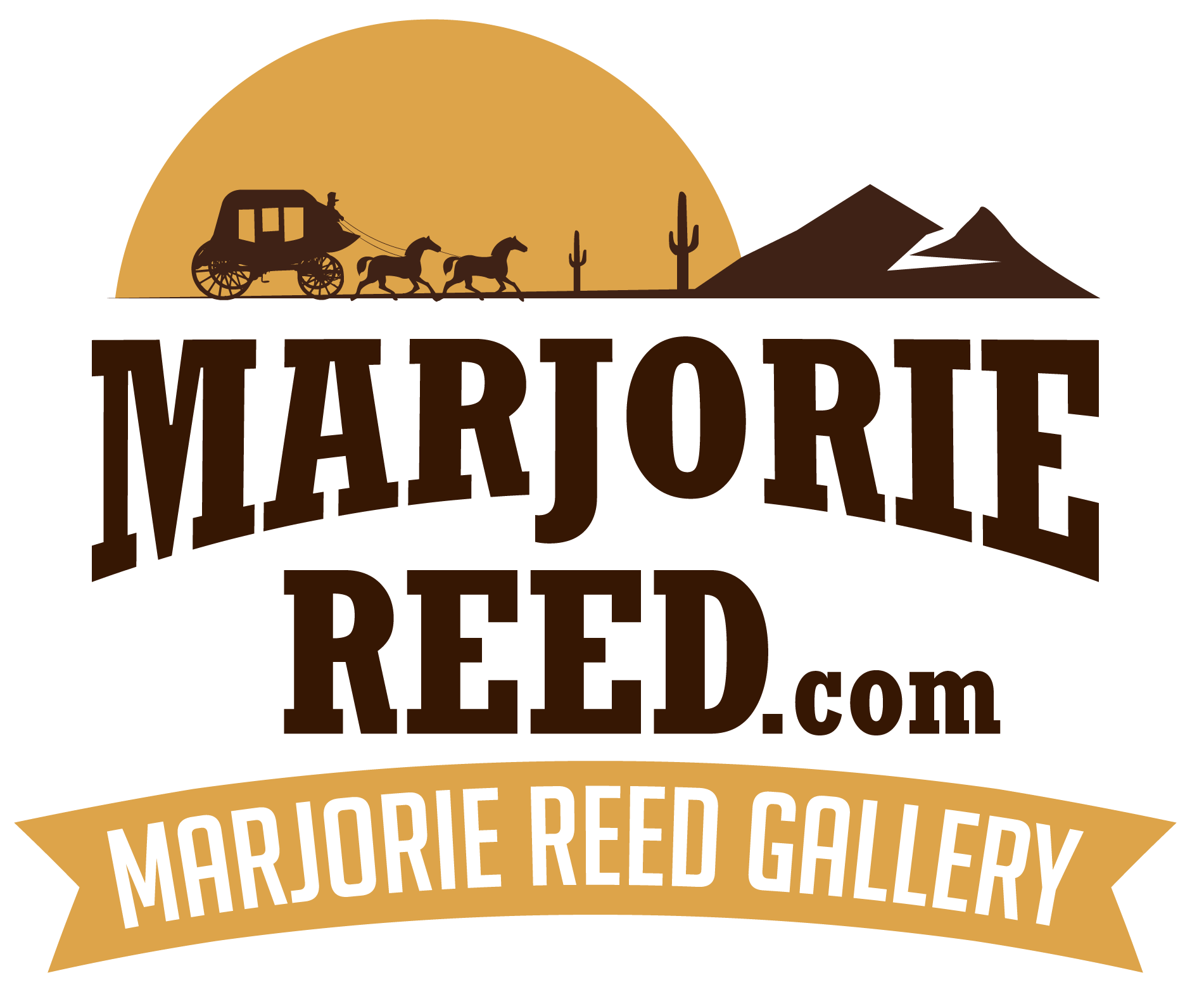Marjorie Reed by Ed Ainsworth from The Cowboy in Art
So great was the inner urge of Marjorie Reed to paint horses that when she was a girl she walked eighteen miles to sit on a corral fence to watch and sketch them in action. She has since concluded that her painting of horses resulted from frustration because of her great desire to live on a ranch, an ambition that did not materialize. While Marjorie Reed was yearning for a ranch life, she was busily occupied under the tutelage of her father in learning to draw and paint. Her father, Walter Reed of Springfield, Illinois (where Marjorie was born on February 22, 1915), was a commercial artist, and her mother possessed a fine artistic appreciation. The girl began drawing long before she went to school and then, in her father’s studio, designed Chrismascardsformrjor companies and worked for a subsidiary owned by Walt Disney when she was onl fourteen. Her work attracted the attention of Disney, who sought to place her in the animation department of his studios, but, as she says, I couldn’t adjust to the regimentation.
This yearning for a free lift in the ranching country could not be satisfied on the outskirts of Los Angeles, where Marjorie Reed grew up after the family moved west. Of a deeply religious nature, Marjorie feelsthat through her frustration in being denied a ranching life she was enabled to turn to her art, and to be rewarded by giving pleasure to those who enjoy her work. Only by returning the gift of the Creator can we alleviate this frustration, she says about her ability to paint. Most of the credit for her formal training she gives to Jack Wilkinson Smith of Alhambra, with while she studies for two years. Here extraordinary talent for western portrayals flowered in a series of twenty paintings showing stagecoaches on the old Butterfield Stage Route. These paintings attracted national attention and were acquired by James S. Copley.
A love of horses and western history inspired Marjorie Reed to recreate in oils various incidents and phases of the old west. She acquired early training in drawing at her father’s commercial art studio in Los Angeles. Two years of study with the noted California artist, Jack Wilkinson Smith, gave the young artist the technical knowledge and inspiration to put them on canvas. Following the Butterfield Trail and making a group of twenty paintings of stations and incidents of action and color I each state the line traversed has become a lifelong project for he artist.
Just 100 years after the initial Butterfield coach left Tipton, Missouri the first series of 20 paintings of the trail through California was completed and purchased by James S. Copley, owner of Copley Books and The Sand Diego Union-Tribute, and in 1971 The Colorful Butterfield Overland Stage was published. The original paintings are hanging in the Butterfield Room of Las Casa del Zorro in the Anza-Borrego Desert State Park, California. And now the second series, The Butterfield Overland Stage Across Arizona, to be followed by a third series, The Butterfield Trail Though New Mexico and Texas.
Colbert’s Ferry at Red River – After paying our dollar and a quarter ferry fee, our conductor boards the front box beside the driver, and we area on our way across the Red River on a long flat boat poled by negro salves who belong to the ferry owner, Mr. B.F Colbert. Mr. Colbert, a wealthy and influential Chickasaw citizen, also owns the log home used as a Butterfield station. This is our warm and welcome beginning to be sure. An excellent meal which included sugar, butter and pastry, corn and vegetables raised on this fine farm is partaken of with much delight after the desert fare we have recently endured. But now we must leave for our next stop. Fisher’s, as our conductor is loudly announceing All Aboard.
Thirteen miles over a goodhard packed road brings us to Fisher’s Stand, and after a quick change of horses, we are on our way to Nail’s Station on the Blue River. At this station we are told by our host of the surprise Mr. Waterman Ormsby, Correspondent for the New York Herald, and first through passenger on the initial run of the Butterfield Mail, experience when seeing a copy of the Herald at this station, nearly seventeen hundred miles from New York.
As nighttime approaches we are traveling over a quite rough piece of track, and all passengers are feeling rather fatigued. So it is with some relief that we see the lights of our next stop, Boggy Depot, through the trees in this heavily wooded sector. The imposing two story home of Governor, Allen Wright, appears before us. With the proximity of Fort Washita, a military post established for the protection of the Chickasaw and Choctaw tribes of friendly disposition, we notice a number of soldiers in the area, some een accompanying our coach to the station. The Butterfield supplies the fort through it’s office at this station. A fairly decent meal is served us at Guy’s Hotel while fresh horses are being hitched, and again we are back on the trail, our next stop at Geary’s sixteen miles distant.



